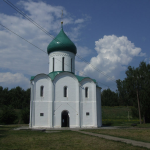Spaso-Preobrazhensky Cathedral in Pereslavl Zalessky
One-dome cross-in-square four-pillar triapsidal Spaso-Preobrazhensky Cathedral in Pereslavl-Zalessky is the earliest of all white-stone architectural monuments of the North-Eastern Rus. The temple was laid by Yuri Dolgoruky in 1152, and finished under Andrei Bogolyubsky in 1157.
The walls of the temple are laid in a half-rubble technique of perfectly cut white stone blocks put on top of one another almost without any mortar. The walls are from 1 metre 30 centimetres to 1 metre thick. The height of the temple in the old days was around 22 metres.
The temple has a continuous foundation (running from the pillars to the walls), which was already archaic for its time. The foundation is laid of large boulders upon lime . The depth is 1.2 metres, it is carried to the layer of dense clay. It is much wider than the walls, protruding 1 meter from the north and 1.5 metres from the east. It goes straight to the depth of 0.8 metres, and then narrows down.
The building has “grown into the ground” for 90 centimetres in comparison to the pre-Mongol time; below the top flashing line there are two more layers of white stone socle.
The temple’s decoration is very austere. The drum is adorned with a decorative band and crenulated belt, on top of the apses there is an arcaded frieze, decorative band, and carved moulding.
During the excavations in the temple at the end of the 1930s, yellow, green, and brown maiolica tiles were found, that covered the floor. Smarter tiles, white with blue ornament, probably, decorated the choir.
From the ancient times to this day, the temple remains one of the dominant urban elements of Peresavl Zalessky.
In the past, it served as burial chapel of Pereslavl apanage princes. Here the tombs of the Grand Prince of Vladimir Dmitry Alexandrovich, Alexander Nevsky’s son, and Pereslavl apanage prince Ivan Dmitrievich, the grandson of the great general are located.
In the second half of the 12th century, the cathedral was decorated with frescoes. In 1862, local historian and architect N. A. Artleben found the pieces Last Judgement and Our Lady on the Throne.
During the restoration of the cathedral in 1893-1894, the old frescoes were taken off in small fragments, put into boxes, and stored in an unheated facility in disorder. In 1895, the archaeological commission recognised the frescoes as unfit for further preservation.
The preserved fragment of the paintings (waist portrait of Apostle Simon) is now kept in the Historical museum in Moscow.
Transfiguration, the icon of the early 15th century, was located in the cathedral, allegedly painted by Theophanes the Greek; now it is preserved at the Tretyakov Gallery.
The frescoes of the 19th century, which had no significant artistic value, were cleared. Now the cathedral has white walls inside.
The cathedral is the only one of the first five white stone cathedrals that has survived till our days almost completely intact.
Many Pereslavl princes were baptised in the cathedral, including, most probably, Alexander Nevsky, who was born in Pereslavl in 1220.
In the XIII—XIV centuries, Spaso-Preobrazhensky Cathedral was a burial chapel of the Pereslavl apanage princes. Princes Dmitri Alexandrovich and Ivan Dmitrievich were buried here. During the excavations in 1939, a rare triangle-dented decorated sarcophagus lid from the tomb of Ivan Dmitrievich was discovered.
In September of 1945, the museum of Alexander Nevsky was opened in the cathedral.

